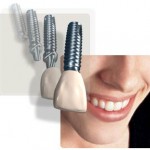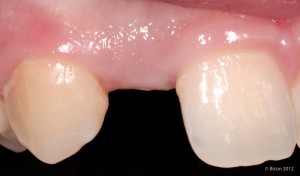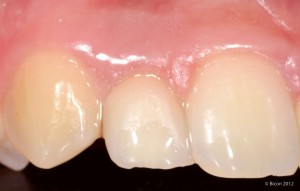
Single Tooth Implants – When Are They Used?
Single tooth implants can be used in people who are missing one or more teeth. This allows you to preserve your natural teeth, while restoring function. A dental implant is surgically placed in an opening that is made in the jawbone. You will be pleasantly surprised how comfortable this procedure will be. After the implant integrates (attaches) to your bone, it acts as a new “root” for the crown that will be replacing your missing tooth. A crown (cap), which is made to look and function like a natural tooth, is attached to the single tooth implant and fills the space left in the mouth by the missing tooth, restoring a beautiful smile, and your ability to eat well.
For this procedure to be considered, there must be enough bone in the jaw, and the bone has to be strong enough to hold and support the single tooth implant. If there is not enough bone, it may need to be added with a procedure called bone augmentation. In addition, natural teeth and supporting tissues near where the implant will be placed must be in good health.
How Do Single Tooth Implants Work?
An implant-restored tooth consists of several parts.
- The implant, which is made of titanium, is placed in the upper or lower jawbone.
- The abutment, which can be made of titanium, precious metals, or porcalain, is attached to the implant with a screw. This part connects the implant to the crown.
- The restoration, the part that looks like a tooth, is a crown, often made of porcelain fused to a metal alloy (PFM), but also could be an all-porcelain or all-metal crown.
The crown is then attached to the implant abutment by a special dental cement, resulting in a complete tooth, supported by your dental implant.
The Single Tooth Implant Process
The time frame for completing the single tooth implant and crown depends on many factors. When the traditional method of placing a dental implant is used, the shortest time frame for a completed implant (including surgery and placing the permanent crown) is from three to six months. Often, an implant can be placed at the time of extraction of a tooth, which will save much time. However, the process can last up to a year or more, particularly if bone needs to be added first.
In the traditional method, two procedures are required, within a time frame of three to six months. During the first, an incision is made in the gum where the single tooth implant will be placed. A hole is drilled in the bone, the dental implant is placed into the hole in the bone, and the incision is stitched closed.
At the end of the healing period, a second procedure takes place. The abutment is screwed onto the top of the single tooth implant, and is used to support the crown. The dental implant is now ready to receive the new crown.
Initial Consultation
 The Implant Dentist will do a comprehensive examination. During the exam, he will review your medical and dental history, take X-rays, and may create impressions of your teeth and gums so that models can be made. In some cases, he also may order a CT (computerized tomography) scan of your mouth. This x-ray scan will help the doctor determine how much jawbone is available to hold the single tooth implant in place, and will show the location of structures such as nerves and sinuses (located above your upper teeth) so they can be avoided during surgery. If the X-rays show that your jaw does not have enough bone to hold a dental implant, he can discuss options, such as bone grafting and bone expansion, for building up the bone. If you need one of these procedures, it may take 3 to 6 months for the bone to be ready for the single tooth implant.
The Implant Dentist will do a comprehensive examination. During the exam, he will review your medical and dental history, take X-rays, and may create impressions of your teeth and gums so that models can be made. In some cases, he also may order a CT (computerized tomography) scan of your mouth. This x-ray scan will help the doctor determine how much jawbone is available to hold the single tooth implant in place, and will show the location of structures such as nerves and sinuses (located above your upper teeth) so they can be avoided during surgery. If the X-rays show that your jaw does not have enough bone to hold a dental implant, he can discuss options, such as bone grafting and bone expansion, for building up the bone. If you need one of these procedures, it may take 3 to 6 months for the bone to be ready for the single tooth implant.
First Procedure: Dental Implant Placement
Once it has been determined that you have enough bone to successfully hold a single tooth implant, you will schedule the surgery, which involves placing the dental implant in your jaw. the implant dentist uses the most advanced techniques available to ensure your utmost comfort and the success of your single tooth implant.
Although there are several types of dental implants, the most popular type are root-form implants designed to serve as the root of the tooth. They are placed in the jawbone in the space created by the missing tooth. After this procedure, a time period of three to six months, is necessary to allow for the bone and the single tooth implant to bond together.
Second Procedure: Placing the Abutment
Once the dental implant has become bonded with the bone, you can schedule this procedure. The Implant Dentist will confirm whether the single tooth implant is ready for the crown by taking an X-ray. This procedure is much simpler than the first. The dentist will expose the head (top) of the single tooth implant.
An abutment is placed on the single tooth implant. The abutment is screwed onto the dental implant and tightened, using special equipment so that it won’t come loose. After the abutment is attached to the implant, a temporary crown is placed on the abutment. The temporary crown will be in place for two to four weeks. The gums will heal around it and will look like the gums around your natural teeth. The temporary crown is made of softer material than the permanent crown.
Final Procedure: Placement of a Permanent Crown
 While you are wearing your temporary crown, the permanent crown will be made. It takes about two to three weeks, sometimes less, to make a permanent crown. The crown will be created from a model of your teeth and gums. The finished crown will be cemented to the abutment.
While you are wearing your temporary crown, the permanent crown will be made. It takes about two to three weeks, sometimes less, to make a permanent crown. The crown will be created from a model of your teeth and gums. The finished crown will be cemented to the abutment.
Caring for Your Dental Implants
You care for your dental implants the same way you care for your natural teeth. It is important to brush and floss daily. Your dentist will suggest a regular schedule of professional cleaning with his hygienist, just as with natural teeth.
What Will X-Rays Show?
 On an X-ray, you will be able to see the single tooth implant in the bone, the connection between the dental implant and the abutment, and the abutment and the crown. The Doctor will be able to see that the implant, abutment, and crown fit together well, to help ensure long-term success.
On an X-ray, you will be able to see the single tooth implant in the bone, the connection between the dental implant and the abutment, and the abutment and the crown. The Doctor will be able to see that the implant, abutment, and crown fit together well, to help ensure long-term success.
What Can You Expect From Your Dental Implant?
Dental implants will function and look like your natural teeth. This means that you will be able to eat what you want, without fear of embarrassment. They actually become a part of you, while also making possible that beautiful smile!
Call Opelika Dental Implants TODAY at (334) 528-0175 for your consultation appointment. You’ll be glad you called us about your single tooth implant options.
